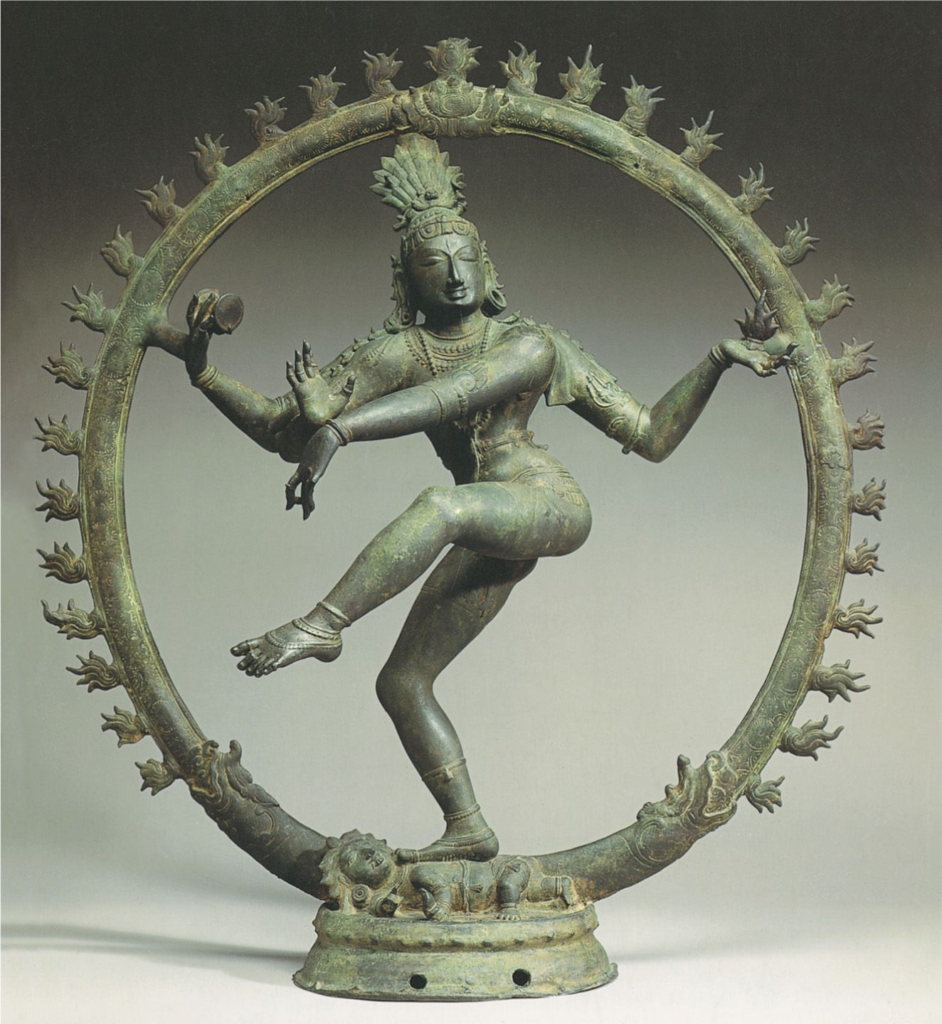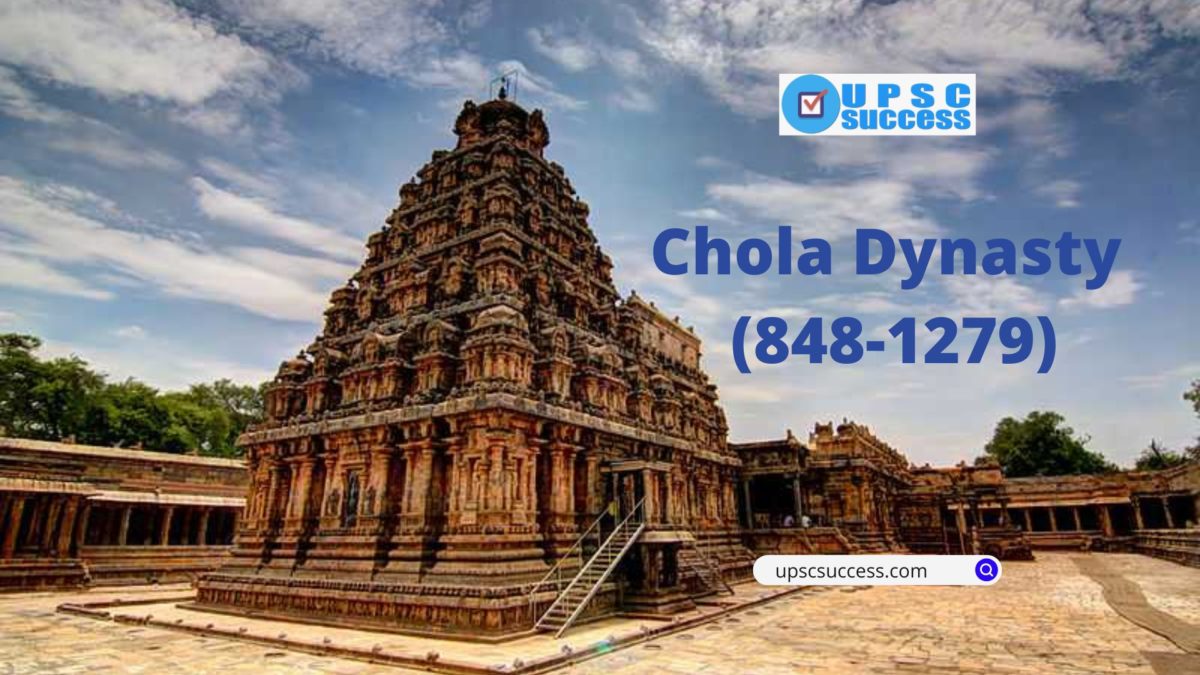Contents
The Chola dynasty was a Tamil dynasty in southern India. They are one of the longest-ruling dynasties in history. The earliest references to the Chola dynasty can be traced to Sangam Age.
The Heartland of the Chola kingdom was the valley of the Kaveri River.
More than 10,000 inscriptions engraved on copper and stone form the primary sources for the study of Chola history.
Literary sources, such as Tamil literature flourished during this period. The rise in bhakti saints and compilation of hymns reflect sociocultural features of that period Muvarula, and Kamba Ramayanam, the great epic, belong to this period

Chola Dynasty Kings
| Medieval Cholas | |
| Vijayalaya Chola | 848-871(?) |
| Aditya I | 871-907 |
| Parantaka Chola I | 907-950 |
| Gandaraditya | 950-957 |
| Arinjaya Chola | 956-957 |
| Sundara Chola | 957-970 |
| Uttama Chola | 970-985 |
| Rajaraja Chola I | 985-1014 |
| Rajendra Chola I | 1012-1044 |
| Rajadhiraja Chola | 1018-1054 |
| Rajendra Chola II | 1051-1063 |
| Virarajendra Chola | 1063-1070 |
| Athirajendra Chola | 1067-1070 |
| Chalukya Cholas | |
| Kulothunga Chola I | 1070-1120 |
| Vikrama Chola | 1118-1135 |
| Kulothunga Chola II | 1133-1150 |
| Rajaraja Chola II | 1146-1163 |
| Rajadhiraja Chola II | 1163-1178 |
| Kulothunga Chola III | 1178-1218 |
| Rajaraja Chola III | 1216-1256 |
| Rajendra Chola III | 1246-1279 |
Vijayalaya Chola (848–871)
- Vijayalaya was the founder of the Chola Dynasty.
- He captured Tanjore from Muttarayar, an ally of the Pandyas, around 850 AD.
- He founded the temple of Nishumbhasudini (Durga) in Thanjavur, Tamil Nadu.
- They were feudatories of the Pallavas.
Aditya Chola (891–907)
- Aditya Chola defeated and murdered his Pallava overlord Aparajita and occupied the entire Tondaimandalam.
- He conquered the Kongu country as well.
- He is said to have built Siva temples on both banks of the Kaveri river.
Parantaka I (907–950)
- At the start of his reign, Parantaka I invaded the Pandya territory.
- Parantaka I assumed the title of ‘Maduraikonda’ (Conqueror of Madurai).
- Uttaramerur inscription tells about his region.
- Krishna Ill, one of the greatest Rashtrakuta rulers, defeated Parantaka in the famous battle of Takkolam (near Arkonam) in 949 AD.
Rajaraja Chola I (985–1014)

- The real greatness of the Chola kingdom began with Rajaraja Chola I.
- He is also known as Arumolivarman.
- Rajaraja Chola I defeated a confederation of the three kingdoms of Pandya, Kerala and Ceylon.
- He destructed the Anuradhapura after defeating north Ceylon.
- Rajaraja Chola I also annexed the Maldives probably for securing the trade routes of the Indian Ocean.
- He built the Famous Rajeshwara / Brihadeshwara temple at Thanjavur (Dravida Style) in 1010 AD.
- Rajaraja Chola I encouraged Sailendra ruler of Srivijaya (South-East Asia), to build a Buddhist vihara at Nagapattinam.
- The vihara was called ‘Chudamani Vihara‘.
Rajendra Chola I (1012–1044)
- Rajendra I conducted the most striking military exploit after his accession in 1023 by his expedition to northern India.
- Rajendra Chola defeated southern Srilanka & annexed the whole Cylon (Srilanka).
- He moved to the north & Captured Bengal defeating Mahipala I.
- Rajendra Chola assumed title of Gangaikonda Chola.
- He conquered the Malay Peninsula & converted the Bay of Bengal to Chola lake for trading purposes with China.
- He founded the new capital of the Chola dynasty Gangaikondacholapuram at Kaveri valley.
- Rajendra Chola also built the famous Gangaikondachola Temple (Dravida style) in the new capital of the Chola dynasty.
- In 1025, Rajendra Chola sent an expedition to Sumatra and Malaya and defeated the ruler of the Srivijaya empire.
- He established many educational institutes in his empire, for this he got the title Pandita chola.
- In 1015 and 1033 Rajendra Chola I sent diplomatic missions to China.
Rajadhiraja (1044–1054)
- Rajadhiraja suppressed rebellions in Pandya, Kerala and Ceylon kingdoms.
- He performed the virabhisheka.
- It was the coronation of the victory there and assumed the title of ‘Vijayarajendra’.
Kulottunga I (1070–1120)
- Kulottunga I is the son of Rajaraja Narendra of Vengi and Chola princess Ammangadevi.
- He united the Vengi kingdom with the Chola kingdom.
- Kulottunga I sent a large embassy of 72 merchants to China.
- Suryavarman Il, the builder of Angkor Wat, sent a precious jewel to Kulottunga who then donated it to the temple of Chidambaram in 1114 AD.
- Last Chola dynasty king was Rajendra Chola III (1246–1279).
Rajendra III (1246-1279)
He was the last Chola king who was defeated by Jatavarman Sundarapandya II. On the ruins of the Chola empire, Pandya and Hoysala kingdoms came into existence.
Chola Administration
King: The emperor or king was at the top of the administration. All authority rested in his hands. He often went on tours in order to keep better touch with the administration.
Chola rulers appointed Brahmins as spiritual preceptors or rajagurus (the kingdom’s guide). Rajaraja I and Rajendra I mention the names of rajagurus and Sarva-sivas in their inscriptions.
Chola kings granted huge estates of land to Brahmins as brahmadeyams and caturvedimangalams..
Provinces: The Chola Kingdom was divided into Mandalams or provinces.
Mandalams were further divided into Towns and Villages.
Autonomous administration for towns and townships, known as Tankurrams.
Town autonomy was quite similar to village autonomy and both were administered by assemblies.
In the sabha, membership was restricted to the Brahmins of the village or was found exclusively in a village gifted to Brahmins.
The nagaram was found more commonly in trade centres such as cities and towns.
Military administration: The Cholas maintained a large army consisting of infantry, cavalry and elephants which were called the three limbs of the army. The venetian traveller Marco Polo says that all the bodyguards of the king burnt themselves on the funeral pyre of the dead king.
Public Works in Chola Kingdom
Extensive irrigation works, roads and cities were made in the time of Chola dynasty.
They made an artificial lake (16 miles in length) near Gangaikonda Cholapuram, and constructed dams across the Kaveri river for irrigation purposes.
Trade & Diplomacy of Chola Dynasty

Merchants, who operated locally were called swadeshi and those who operated internationally called nanadesi.
The merchants had their own settlements (nagara) with autonomous institutions of local government.
The great ports (pattinam) also had their guilds and autonomous institutions.
They financed local development projects, and the construction of temples, and lent money to the Chola kings.
Among the most powerful guilds were the Ayyavole and the Manigramam. Ayyavole extended to West Asia, while the Manigramam concentrated on trade with South-East Asia.
Religion

Chola rulers were ardent Saivite. Shiva was the preeminent god for the Cholas and he was represented in two forms. The iconic form of Siva was Lingodhbhava, and the Nataraja idol was the human form.
A highly evolved philosophical system called Saiva Siddhanta was founded
during this period.
Kulathunga Chola was ardent shaivite. He persecuted vaishnavites. Bhakti saint Ramnujacharya left Srirangam and settled in Melkote,Karntaka.
Literature
Tamil and Sanskrit languages flourished during the Chola period. Tamil literature witnessed golden age.
Few Tamil literary works are:
- Kamban Ramayan by Kamban (Tamil Ramayan)
- Periyapuranam or Tiruttondarpuranam by Sekkilar
- Kalladam by Kalladanar
- Nalavenba was written by Pugalendi etc.
Kesava swami composed the Sanskrit work nannaranava samkshevam.
Architecture
Chola art saw culmination of dravida temple art resulting in most sophisticated buildings.
They used material of stone instead of bricks due to its greater durability. Neatly detailed frescos including birds, dancing figurines and other pictorial stories from Puranas. Some temples have potraits of the Kings and queens themselves.
The temples had a Garbhaghriha(Deity room); Vimana(Brihadeshwara Temple); Shikhara(Stone weighing 90 tonne); Mandap. Metal Art(Nataraja at Chidamabaram Temple) Lofty Gates
Examples include Brihadeswara , Vijayalaya temples


Chola bronze sculptures

The cire-perdu or ‘lost-wax’ process for casting was learnt as long ago as the Indus Valley Culture. Along with it was discovered the process of making alloy of metals by mixing copper, zinc and tin which is called bronze. The bronze casting technique and making of bronze images of traditional icons reached a high stage of development in South India during the medieval period.
The well-known dancing figure of Shiva as Nataraja was evolved and fully developed during the Chola Period and since then many variations of this complex bronze image have been modelled.
A wide range of Shiva iconography was evolved in the Thanjavur (Tanjore) region of Tamil Nadu. The ninth century kalyanasundara murti is highly remarkable for the manner in which Panigrahana (ceremony of marriage) is represented by two separate statuettes.
Shiva with his extended right hand accepts Parvati’s (the bride’s) right hand, who is depicted with a bashful expression and taking a step forward.
The union of Shiva and Parvati is very ingeniously represented in the Ardhanarisvara Murti (in fig) in a single image.
Chola bronzes are the most sought-after collectors’ items by art lovers all over the world.
FAQs
Rajaraja- I was the greatest ruler of the Chola dynasty. He defeated Cheras at Thiruvananthapuram to control the trade with Arabs.
The Chola dynasty came to an end in 1279, when King Maravarman Kulasekara Pandyan I defeated the last Chola king, Rajendra Chola III, and established Pandya’s rule.

